Risks associated with contact lens wear
Eyes are one of the precious gifts awarded to us by nature so we can see the colors and charms of this world. Imagine how boring or dull the life would be without the eyes. We cannot appreciate the significance of this blessing until or unless we come across eye related problems and diseases. Being a human, it’s in our instinct that we cannot remain contended on what nature has blessed us with.
Having attractive eyes is the dream of millions of people, especially the women who would love to pay any price just to look more attractive. That is why wearing contact lens has become a trend now. A contact lens is thin flexible lens made up of plastic material that is placed on the surface of eye to either correct the vision problem or for cosmetic purposes.
People who are having vision problems; they wear contact lenses for the therapeutic purposes to make the vision much better. Various refractive errors of eye like near sightedness, far sightedness, astigmatism and keratoconus can be improved to a great deal by wearing contact lenses. Also the people who undergo cataract surgery without lens implantation can also use contact lens afterward to get a corrected vision.
No doubt, contact lenses are handy and easy to use. They seem to be a sigh of relief for those who have to wear glasses all the time.
But that was just one side of the picture. There is an ugly side of this picture too, which also needs your attention. Wearing contact lens seems to be the best option to get rid of the ugly looking glasses but remember that extended wear or continuous wear lenses can put you at the risk of many optic complications. The types of contact lenses vary according to the material they are synthesized of. The contact lenses can be rigid or soft, with some of them are used for daily wear while others are used for extended wear as you can sleep with these lenses in your eyes.
- Rigid lenses: They are also called hard lenses or gas permeable lenses and are made up of polymethyl methacrylate. These lenses are not much popular these days.
- Soft lenses: These lenses are superior to the rigid lenses because they contain hydrogel material that is more oxygen permeable.
The complication or risks induced by wearing contact lenses vary from minor ailments to serious eye diseases. Here will be described the major complication that appear as a result of wearing contact lenses.
Infections
Being exposed to the environment all the time, the chance of getting dust, foreign particles or infections into the eyes are more. But in order to prevent this from happening, the nature has equipped our eyes with protective mechanism. These protective mechanisms tend to clear away the foreign particles and infections from the eyes. There are two protective mechanisms in the eyes.
One is tear film and another one is blinking of the eye lids. Tear film provides lubrication to the exposed surface of the eyes and fights the infection through the action of lysozyme enzyme it contains. This enzyme digests the bacteria and prevents them from growing. The role of other protective mechanism, that is blinking, is to continuously replace the existing tear film with the new one. So when we blink the eyes, if there is any foreign particle sticking to the eyes surface, it will be washed away with the tear film.
But, these protective mechanisms get disturbed when you wear contact lens for a long period of time. While wearing contact lenses, the tear film cannot be replaced as efficiently as could be done when the lens was not there. Trapping of tear film due the presence of contact lens leads to the deposition of foreign particles on the lens and eye surface. All these factors promote the growth of bacteria in the eyes. The infections, if not treated in time, can progress to various other complications like keratitis and corneal ulcers.
Lid complications
Blepharitis
Another important complication related to contact lenses wear is blepharitis. Blepharitis is the medical term used for the inflammation of eye lids. People who use extended wear contact lenses are prone to suffer from this situation. Many contact lens wearers come with the complaints of dryness, burning and itching sensation in the eyes afterwards.
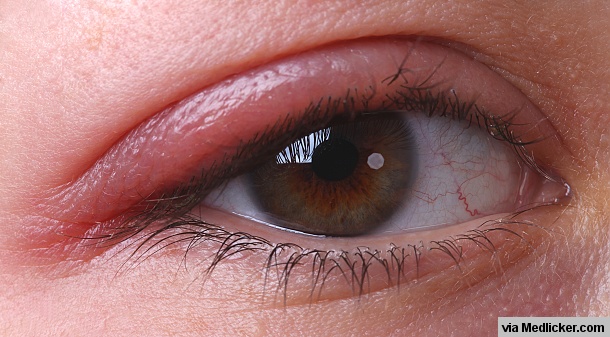
Blepharitis is of two types; one is infectious blepharitis and the other one is squamous or seborrhic blepharitis.
Both types of blepharitis can occur in contact lens wearers. Contact lenses consist of certain synthetic materials that can evoke the allergic or hypersentivity reactions in the eyes. It would be fine to wear the contact lenses for a short period of time but their extended wear can incite the allergy associated inflammatory reaction in the eye lids. This allergy triggered inflammation of eye lids ends up in seborrhic blepharitis. There is deposition of dandruff like greasy material on the eye lid margins associated with matting of eyelashes.
Superinfection of the inflamed eyelids with the bacteria like staphylococcus aureus can exacerbate the situation leading to infectious blepharitis. If infectious blepharitis remains untreated, it may lead to ulceration of the eyelid margins. The only way to stop this condition from getting worse is to avoid wearing contact lenses and to maintain the proper eyelid hygiene. Topical steroids and antibiotic cream prove to be effective in reducing the inflammation of eyelids.
Meibomian gland dysfunction
Here comes the other risk associated with contact lens wear, which is meibomian gland dysfunction. You will not be able to understand this term until you know about the normal meibomian gland function. Meibomian glands are the sebaceous glands located in the both upper and lower eyelids.
The purpose of these meibomian glands is to secrete the oily constituents of tear film. The oily secretions of meibomian gland enable the tears to stay on the surface of the eye in the form of a layer or a film.
Dysfunction of these meibomian glands disturbs the production of these oily secretions that leads to the tear film instability. Well, you can now imagine what will happen if the tear film protecting the eye surface gets affected. The surface of eye becomes dry and there is a feeling of irritation or grittiness in the eyes.
But the question is that how contact lens can cause the dysfunction of meibomian glands?
The research studies are being conducted to find out the reason behind the meibomian gland dysfunction in the contact lens wearers. The exact cause of this is still unknown but is believed that the constituents of the contact lenses play a role in reducing the numbers of meibomian glands.
Those who rely on extended wear lenses and leave them overnight in the eyes; they are more vulnerable to develop meibomian gland dysfunction over time. Chronic irritation of the meibomian glands due to wearing contact lenses causes their inflammation. The inflammation of these glands progresses to various other consequences like distortion of the gland structure, shortening of glands in size and obstruction of the glandular ducts.
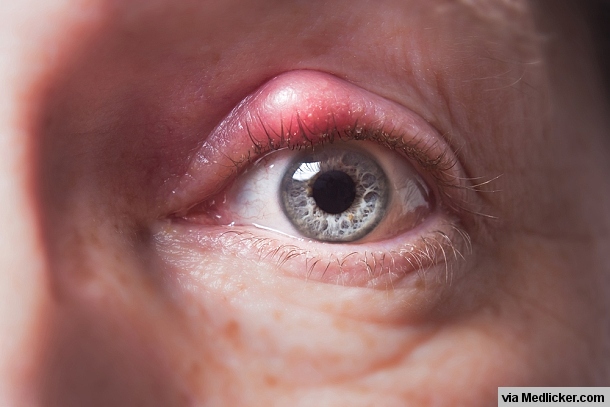
The blockage of glands ducts stops the flow of oily secretions. The secretions become entrapped in the glands leading to their further inflammation and dysfunction. Progressive and chronic inflammation of meibomian glands proceeds to the chalazion formation, blepharitis and dry eye syndrome. Use of disposable contact lenses or their repeated replacement can prevent this from happening.
Dry eye syndrome
If you feel burning, irritation, discomfort and foreign body sensations in the eyes after the prolonged wearing of contact lenses, probably you are suffering from dry eye syndrome. Dry eyes are the commonly faced problem in the extended contact lens wearers. About 40 to 50 percent people come to face this problem with the contact lens wear.
As discussed previously, contact lenses can cause the instability of tear film by disrupting the normal function meibomian gland. The contact lenses not only disturb the production of tears, but they also hamper the continuous replacement of the tears. As the result, the eye surface will become devoid of its natural moisture and lubrication gradually. Now, when the eyelids blink against the dry eye surface, it will cause friction between eyelids and eyes’ exposed surface. This produces the feeling of irritation and discomfort in the eyes.
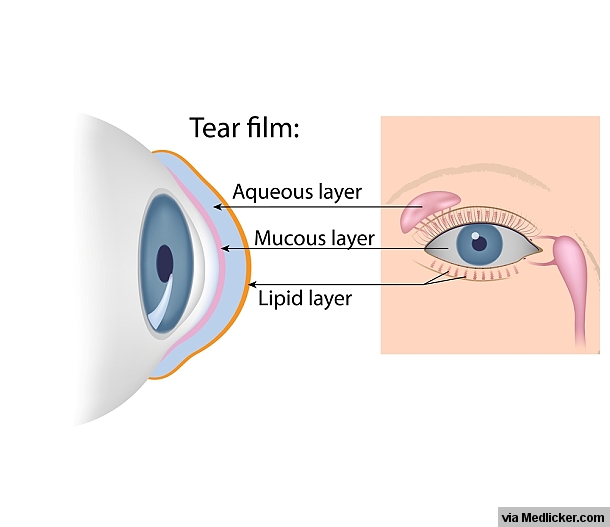
Dry eye is one of the reasons due to which many people discontinue using the contact lens. Especially, people who are already predisposed to the dry eye condition like blepharitis, meibomian gland dysfunction and decreased tear production will not be able to tolerate the contact lenses at all because wearing the contact lenses in such conditions can worsen the symptoms of dry eyes.
Ptosis
Ptosis is a medical condition in which there is drooping of upper lid. The patient of ptosis is unable to open the eyes completely because there is dysfunction of the eyelids. The eye lids contain a muscle called levator palpebrae superioris. The function of this muscle is to contract and to keep the upper lid elevated. But, the function of this crucial muscle of eyelid can be compromised in the people who wear extended usage contact lens. Although rare, yet acquired ptosis is one the complication associated with extended wear contact lenses.
This problem is particularly faced with the use of hard contact lenses rather than the use of soft contact lenses. The synthetic components of hard lenses have the potential to cause trauma or injury to the eye lids. When the eye lids rub against the contact lenses, a frictional effect is produced that can cause damage to the levator muscle. It was found that the continuous wear of contact lenses can cause the disinsertion at the point of insertion of levator muscle.
Once the levator muscle is injured and is disinserted, it will not be able to act effectively. Thus, the loss of the function of levator muscle will eventually result in the drooping of the eye lid. Apart from the trauma to the muscle, the contact lenses cause many other structural changes to it. Contact lenses induce the involutional changes in the levator muscles, causing the progressive weakening of the muscle.
Corneal complications
The exposed part of the eyes that we can see is divided into two parts; one is cornea and the other is sclera. Cornea is the central transparent, round, convex structure that covers one sixth part of the outer layer or surface of the eye. While sclera is the opaque whitish part that surrounds the cornea. Cornea itself is a clear and transparent structure but it appears colored because it reflects the color of underlying iris. The transparency of the cornea must be maintained to get a clear and perfect vision.
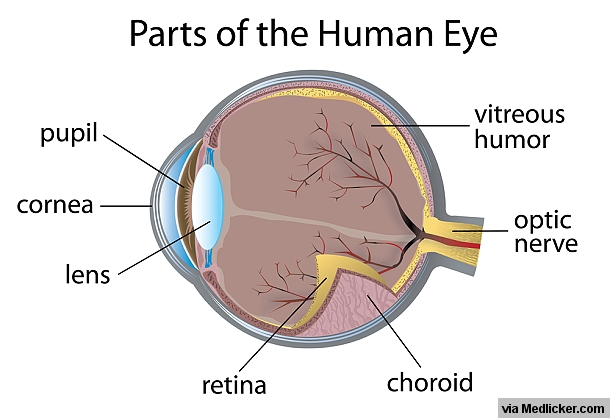
The function of cornea is to permit the light to enter the eyes and to focus the light rays at the retina by bending or refracting them at proper angle. If anything happens to the cornea, it can directly affect the vision quality. There are many factors that can bring about structural and functional variation in cornea. Unfortunately, amongst one of these factors is the wearing of contact lenses. Because when you wear contact lenses the part of the eye that remains more in contact with the lens in cornea, thus cornea is more prone to be affected by the damage induced by contact lenses. After discussing the lid complications of contact lenses; its turn to discuss the corneal complications of the contact lenses, as they are more dangerous than the lid complications.
Corneal hypoxia
Cornea is an avascular structure that does not have its own blood supply. It is composed of five layers; the inner endothelial layer receives their nutrition through the aqueous humour present in the eye chamber. Whereas, the outer layers of the cornea are dependent on the tear film for their oxygen supply. Oxygen first dissolves into the tear film covering the eye surface and it is then taken up by corneal cells. This is how the cornea meets its nutritional demands to stay functional.
Wearing contact lenses interferes with the proper oxygenation of corneal layers. The contact lens is supposed to float over the tear film in front of the cornea. It's obvious that presence of contact lens in front of the cornea will act as a barrier to prevent the absorption of oxygen into the tear film. The decreased diffusion of oxygen or hypoxia initiates a chain of structural changes in the cornea. In response to the hypoxia induced by contact lenses, the epithelial and stromal cells of the cornea start proliferating.
It’s a bit tricky to understand the process of corneal thickening. When some of the corneal epithelial cells die as a result of hypoxia, the corneal epithelium tries to compensate this loss by regenerating the epithelial cell. This rapid proliferation of corneal epithelial cells leads to the corneal thickness. Due the proliferation of corneal epithelial cells, there is formation of fluid filled vacuoles in the corneal epithelium that are called microcysts.
Apart from the corneal thickness and appearance of microcysts, other hallmark of the corneal hypoxia is the corneal neovascularization (formation of new blood vessel). Normal cornea is a completely avascular structure but under hypoxic conditions, the blood vessels start forming in the corneal layers in order to cope with the oxygen demands of the corneal tissues. Thus, the corneal thickness and neovascularization induce the changes in the shape of the cornea. As a result of these structural changes, there is swelling of cornea that lead to impaired vision. The incidences of corneal hypoxia occur in those people who continue to wear the contact lens for long term. If the hypoxia persists, it may progress to corneal ulceration and scarring that can markedly reduce the vision quality.
Microbial keratitis
The inflammation of cornea is known as keratistis. As explained previously, cornea is particularly more at risk to get inflamed due to its close proximity to the contact lens. Under normal circumstances, the cornea remains protected as long as it is surrounded by the protective tear film that has antibacterial properties. But long term use of contact lenses disturbs this delicate and natural balance of tear film. Along with causing the dryness of cornea, the continuous use of contact lenses causes abrasion of the superficial epithelial cells of the cornea.
So, once the protective barrier of tear film and corneal epithelium is gone, microorganism like bacteria, viruses and fungi will find their way to infect the inflamed cornea. Some of the bacteria have adhesive properties that make them stick to the damaged cornea. Microbial keratitis is one of the serious complications of the contact lens wear. The average incidence rate of microbial keratitis is 20 cases per 10,000 persons.
Although rare yet the possibility of this complication cannot be ruled out completely. The commonest organisms that cause this complication are the staphylococcus and pseudomonas aeruginosa bacteria. Apart from bacteria, viruses like herpes simples and adeno virus can also cause the severe keratitis. While, among the fungi, the Aspergillus, Fusarium and Candida are responsible for causing the keratitis. When the bacteria and other organisms gain entry into the corneal layers, a series of inflammatory responses are evoked in the corneal tissues that causes swelling, pain, increased tear production or discharged, blurred vision and increased sensitivity to light.
Prolonged persistence of microbial keratitis will end up in cornel scarring that can only be treated through corneal transplant.
Acanthamoeba keratitis
Acanthamoeba keratitis is another form of keratitis but it needs special as it is a potentially blinding condition that needs to be treated immediately. Acanthamoeba is a fresh water protozoan that causes serious blinding keratitis, especially in those people who do swimming while wearing contact lenses. While swimming the amoeba will stick to the contact lenses and then start digesting the corneal layers afterwards. The patients of acanthamoeba keratitis present with the complaints of severe pain, blurred vision and increased sensitivity to light. If the condition is not treated immediately it may end up in blindness
Corneal ulcers
Corneal ulcers are formed when there is erosion or excavation of the superficial surface of the cornea. Corneal ulcers are actually the sequel of either corneal hypoxia or microbial keratitis. When the corneal epithelial cells start dying out at a rapid rate due to the hypoxia or microbial keratitis, there is a formation of ulcer.
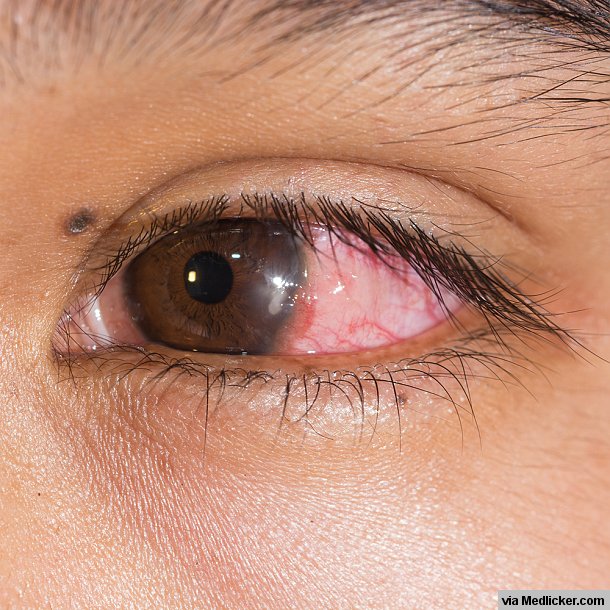
Corneal ulcer is associated with extreme pain, blurred vision, lacrimation and photophobia. If the ulcer is not treated immediately, there are chances that it may undergo perforation that gives rise to many other complications. There can be prolapse of the iris, dislocation of the lens and the cataract formation in the lens. Thus corneal ulcer is considered as one of the potential risks of long term contact lens wear.
Conjunctival complications
Allergic conjunctivitis
Conjunctiva is a protective moist membrane that covers the internal part of eyelids and exposed surfaces of eye ball. This membrane smoothens the blinking of eyelids against the eye surface. But the use of contact lens can cause its inflammation too. This is called conjunctivitis. Allergic conjunctivitis is very common with the prolonged use of contact lenses. As contact lens is foreign body, our body will take it as intruder. That is why; sometimes the constituents present in the contact lenses evoke allergic reaction in the conjunctiva that leads to allergic conjunctivitis. The eyes become red, itchy and watery due the allergic conjunctivitis that makes the person intolerant to the contact lenses. Sometimes, the super infection with bacteria can turn the allergic conjunctivitis to bacterial conjunctivitis.
Measures to prevent the contact lens related complications
- Do consult your doctor if you are having refractive error and you want to resolve them by wearing contact lenses. The doctor can suggest you well about the kind of contact lenses that suite you best.
- Adapting proper hygienic measures is the best way to avoid many of the above mentioned complications.
- Wash your hands and eyes before wearing contact lenses and make sure that you completely dry your hands before inserting the lens in the eyes.
- Get accurate information about the technique of insertion and removal of lenses because lack of proper technique can cause trauma or injury to eye structures.
- Once you wear the contact lenses, do not them keep for too long. Remove the lenses when the purpose of wearing them is done. Contact lenses are not the permanent alternative of glasses so you must not be relying on lenses all the time.
- Always take off your contact lenses before swimming.
- Take care of your contact lenses. When you are not wearing them, keep them dipped in the cleansing solution and don’t forget to replace the solution alternatively. Otherwise, foreign particles and dirt will stick to the lenses and when you wear such lenses it may give rise to complications.
| Written by: | Michal Vilímovský (EN) |
|---|---|
| Education: | Physician |
| Published: | August 21, 2014 at 11:50 PM |
| Next scheduled update: | August 21, 2016 at 11:50 PM |
Get more articles like this in your inbox
Sign up for our daily mail and get the best evidence based health, nutrition and beauty articles on the web.

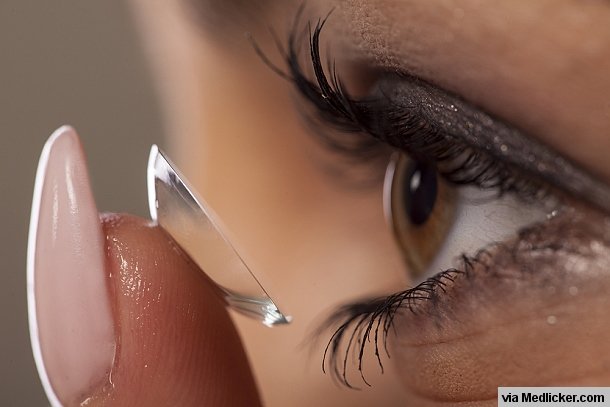
Ache in left arm that you should not ignore
Alkaline water dangers: why you should not drink it
How to Avoid Sleepiness While Studying?
23 Foods That Increase Leptin Sensitivity
Low dopamine (e.g. dopamine deficiency): causes, symptoms, diagnosis and treatment options
Swollen taste buds: the ultimate guide to causes, symptoms and treatment
Thin endometrial lining: causes, symptoms, diagnosis and treatment
Pimples inside nose: the complete guide
Holes in tonsils: definition, symptoms, treatment and prevention
How to deal with an ingrown hair cyst
Allegra vs. Zyrtec vs. Claritin
How to get rid of phlegm (excessive mucus) in throat? Detailed guide to medical and home remedies, symptoms and causes
Allergy to penicillin and alternative antibiotics
What causes stomach ache after meals?
Liver blood test results explained